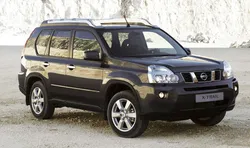

Nissan X-Trail - Generation 2 Overview
Explore the Nissan X-Trail and its second generation, featuring advanced technology and enhanced comfort. Discover all you need to know about the Nissan X-Trail in Portugal.
The Nissan X-Trail, also known as the Nissan Rogue in some markets, is a compact SUV that has made a significant impact since its introduction in 2000. The second generation of the X-Trail debuted in 2007 and ran unt...
Technical Specifications
Select Version
Dimensions
Engine
Driving
Others
History and Features
Mycarro AI
Apr 26, 2025
The Nissan X-Trail, also known as the Nissan Rogue in some markets, is a compact SUV that has made a significant impact since its introduction in 2000. The second generation of the X-Trail debuted in 2007 and ran until 2013, offering a number of enhancements over its predecessor. With a focus on improved performance, comfort, and safety, the second generation aimed to solidify Nissan's position in the competitive SUV segment.
Design and Features
The second generation X-Trail showcased a more modern and aggressive design. It adopted a bolder front end, characterized by a distinctive grille and sharper headlamps. The wider stance and elongated body not only offered a more substantial road presence but also contributed to improved aerodynamics. Inside, the cabin was designed with a focus on quality and practicality, featuring a user-friendly layout that emphasized comfort. High-quality materials adorned the dashboard and seats, creating an inviting atmosphere for both driver and passengers.
One of the standout features of the second generation X-Trail was its versatility. The vehicle came with a "Flexi-Board" cargo system, allowing owners to customize the storage space to fit their needs. Additionally, optional reclining rear seats enhanced passenger comfort, making it an excellent choice for families or anyone needing a capable and spacious vehicle.
Engine Options and Performance
Under the hood, the second-generation X-Trail offered a variety of engine options to cater to different markets and preferences. The lineup included petrol engines ranging from 2.0 to 2.5 liters, delivering a balance between power and fuel efficiency. For those looking for a more economical option, a diesel variant was also available, providing better torque performance.
Performance-wise, the X-Trail was well-received for its smooth handling and comfortable ride. The suspension was tuned to provide a balance between sportiness and comfort, making it ideal for both city driving and highway cruising. Nissan also offered all-wheel-drive variants, enhancing the vehicle's off-road capabilities and ensuring better traction in adverse conditions.
Safety Innovations
Safety was a priority for Nissan during the development of the second-generation X-Trail. The vehicle featured a range of advanced safety technologies designed to protect occupants and prevent accidents. Standard features included multiple airbags, anti-lock braking system (ABS), and electronic stability control (ESC). Higher trims came equipped with additional options such as parking sensors and a rearview camera, further enhancing driver confidence and safety.
The X-Trail also showcased impressive crash test ratings, garnering high marks from various safety organizations around the globe. This commitment to safety played a crucial role in the crossover's appeal, especially among families who prioritize security in their vehicle choices.
Market Performance
The Nissan X-Trail Generation 2 proved to be a commercial success in multiple markets. Its combination of affordability, engaging driving dynamics, and spacious interiors made it attractive to a wide range of consumers. Competing with models such as the Honda CR-V and Toyota RAV4, it held its ground and gained a loyal following.
This generation also saw Nissan expanding its marketing strategies to cater to diverse demographics, capitalizing on the growing demand for SUVs. As fuel prices fluctuated during its production run, the X-Trail's fuel-efficient engines became a significant selling point for budget-conscious buyers.
Legacy and Conclusion
As the second generation of the Nissan X-Trail wrapped up its production in 2013, it laid the foundation for the subsequent model, which continued to evolve in response to consumer demands. The X-Trail Generation 2 is often fondly remembered for its practicality, comfort, and reliability. While it may not draw as much attention as some sportier SUVs, its balance of features ensures that it remains a well-respected choice in the compact SUV market.
In conclusion, the Nissan X-Trail Generation 2 stood out as a well-rounded SUV that successfully blended stylish design, versatile interiors, and robust safety features. Its enduring legacy continues to influence modern iterations of the X-Trail, proving that thoughtful engineering can lead to long-lasting appeal in the competitive automotive landscape.
